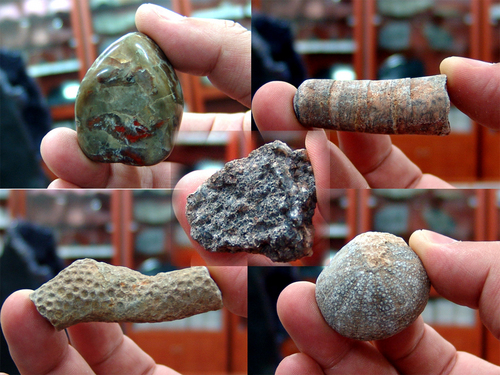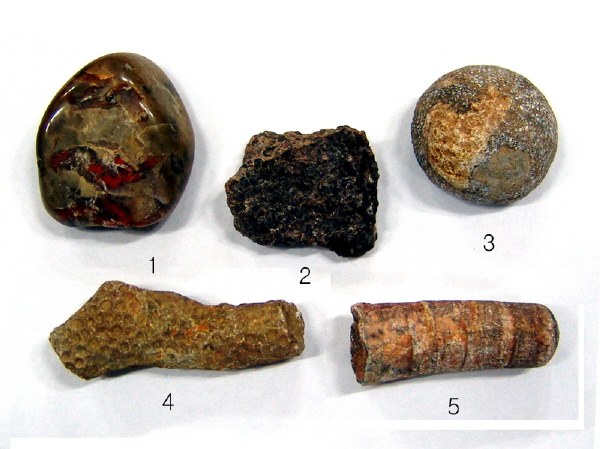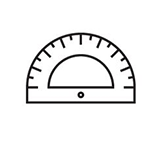표준화석5종세트-3 


| 국내/해외배송 | |
|---|---|
| 배송비 방법 | 택배 |
| 배송비 | 4,000원 (50,000원 이상 구매 시 무료) |
| 수량 |
|
| 상품 정보 | 가격 | 삭제 |
|---|---|---|
| [총 상품금액(수량)] 0 (0개) | ||
1)
일반명 : 공룡똥화석(Fossil Dinosaur Poop)
학 명 : Coprolite
지질시대 Age :중생대 쥬라기 약 1억5천만년전(late Jurassic, 150 million years old.)
지 층 Formation : 모리슨층(Morrison Formation)
원산지 Location : 미국(Emery County, near Moab, Utah)
내 용 : 이 공룡똥화석은 큰덩어리를 파쇄하여 폴리싱(광택)작업을 한것입니다. 이 화석이 발견된곳은 미국 서부의 유타주 모리슨층이며 약 1.5억년된 지층입니다. 공룡 똥인지 아닌지를 아는 포인트는 똥 속의 인산계열의 화학적반응 및 섬유질을함유하고 있는가가 매우 중요하다. 섬유질은 광물로 치환될 수 없기 때문이다.
CARVED DINOSAUR POOP. This is authentic dinosaur "coprolite", fossilized dung, (late Jurassic, 150 million years old), that has been left rough on one side, carved with dinosaur themes on the other! Coprolite is from a
(2)
일반명 : 공룡뼈화석 (Fossil Dinosaur Bone)
학 명 : Triceratops Leg Bone
지질시대 : 중생대 백악기 약1억년전 (Cretaceous. 100 million years old.)
지 층 : 힐크릭층( Hell Creek Formation)
원산지 : 미국 (Harding County, South Dakota.U.S.A.)
내 용 Description : 공룡뼈 화석은 매우큰것부터 매우 작은 것까지 다양한데 그것을 구분하는 방법은 골조직을 현미경관찰함으로서 확인할수 있다. 뼈화석은 위치에 따라 표면은 매우조밀한 조직을가지며 중심으로 갈수록 상대적으로 덜 조밀한 구조를 지니고 있다. 같We offer the Lowest Prices on Dinosaur Bone. There are several places around the world that dinosaur bone is found. However, most of those sites are protected or unaccessible. We have contacted private suppliers worldwide, to obtain these few specimens for your inspection. We seek only high-quality specimens for your consideration.
This is a large section of Triceratops Leg Bone from the Hell Creek Formation,
bones that were buried by volcanic activity or washed downstream and buried in sediments were slowly replaced cell by cell with microscopic quartz. Impurities in the silica cause the replacement to be quite colorful. In many cases, the actual cell structure was preserved and in some cases, the bone casing is still intact. It is increasingly rare to find colorful bone. Few old collections remain from the 30's when most of it was surface mined by old time rock hounds. It is prized by cutters and collectors all over the world.
(3)
일반명 : 성게화석(Fossil Echinoid/ Sea Urchin)
학 명 : Oligopygus sp.
지질시대 : 고생대 실루리아기 약4억년전(Silurian, 400-440 Million years ago)
원산지 : 모로코 (Taouz, Morocco)
내 용 : Commonly called Sea Biscuits or Sea Urchins. Echinoid is Latin for "prickle".
Oligopygus wetherbyi, order Holectypida, Family Oligopygus. When alive, these animals were covered with movable spines which gave protection and provided locomotion. These specimens measure approximately 1.25" to 1.5" in diameter.
(4)
일반명 : 사방산호화석(Fossil Corals)
학 명 : 학명미상
지질시대 : 중생대 백악기 약7천만년전(Cretaceous 70 Million Years Ago.)
지 층 : 울레드압돈층(Ouled Abdoun Basin)
원산지 : 모로코 (Atlas Mountains, Morocco
내 용 : Group of Fossil Coral from Atlas Mountains, Morocco. The largest measures 1 3/8" long. Cretaceous Age. . An excellent addition to any collection. Please email with questions.
(5)
일반명 : 오소세라스(직선형앵무조개)화석 (Fossil Orthoceras)
학 명 : Orthoceras sp.
지질시대 : 고생대 데본기 약3억6천만년전 (Devonian 395 - 345 million years ago)
지 층 : Holzmaden Formation
원산지 : 모로코(Atlas Mountain Range, South Morocco (Northern Sahara Desert)
내 용 : The Southern zone of Morocco, which includes the beginning of the Sahara desert and the last mountains of the Atlas range, is a region very rich in Paleozoic fossils.The fossiliferous sites show how this zone, from the Cambrian to Devonian period (from 600 to 300 million years ago), was occupied by a large marine basin. Among the most important fossils in this area we find the Orthoderatids, which are primitive Nautiloids provided with a conic straight or slightly curved shell, subdivided internally into segments. The shape of the shell allowed these organisms to maintain, during their movements, a horizontal position in perfect hydrostatic equilibrium.
These sea animals were obviously agile swimmers and ferocious carnivorous predators, and could reach remarkable dimensions or one meter or more. After the death of these Nautiloids, the shells were accumulated and covered by sediments. In this manner they fossilized and remained
intact until today.













 확대보기 및 상세정보
확대보기 및 상세정보